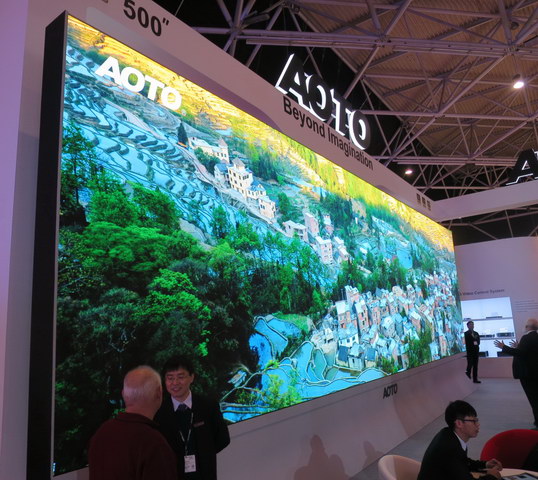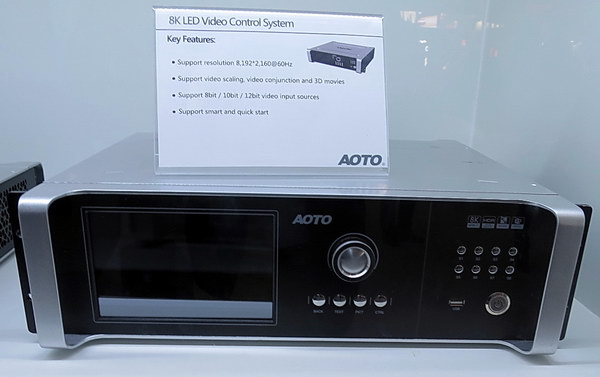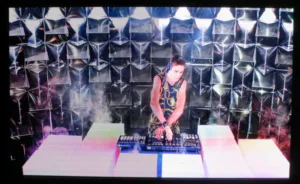Lang AG and Shenzhen Aoto Electronics Co., Ltd. each showed an HDR LED videowall at ISE, Lang in a private suite and Aoto on the trade show floor. Lang is a “dry rental” (that is, it rents equipment, but not people) company in Europe that has a large inventory of projectors and other equipment that it rents to rental and staging companies who either do not own any equipment or do not own enough for a particular job. While many dry rental companies, like VER in the US, are just that, rental companies with large warehouses, Lang also works to develop technology that would be of interest to its customers. Aoto is a Chinese manufacturer of LED videowalls and videowall controllers.
I got a tour of the Lang suite hosted by Markus Ries, Director of the Lang Academy, the training arm of Lang. The most important thing in the suite was a LED videowall showing High Dynamic Range (HDR) content. This videowall had 1000 cd/m² maximum brightness, a color gamut that was about 90% of the DCI-P3 gamut and had a 1.8mm pitch. The screen had 1350 x 810 resolution and almost a 3M diagonal. It could not produce a uniform 1000 cd/m² white image because of limitations on the LED power supply, but it could produce 1000 cd/m² highlights in a normal TV image. This ability to produce very bright highlights is one of the goals of HDR systems. Of course, LED videowalls can have very high contrast, especially in dark rooms, so producing the detail in the low lights is not a problem.
HDR LED videowall in the Lang suite showing SDR content on the left and HDR content on the right.
The content shown on the videowall was encoded using the BBC/NHK hybrid log gamma (HLG) technology, Reis told me. Not surprisingly, since the HDR content shown had been supplied by the BBC. The picture quality was impressive. Other than the need to increase the resolution to match the 4K content, it looked like HDR is supposed to look with details visible in both bright and dark areas. (HLG was used rather than the PQ curve, Ries said, because less of the curve is in the very low levels that remain a challenge from the controller point of view. – BR)
Lang partnered with Aoto in the development of this video wall. Reis said Lang chose Aoto as a partner because the company develops its own LED videowall drive electronics and software, rather than outsourcing like many Chinese companies in the videowall business. This simplified the interaction between Lang and Aoto since it was not necessary to involve third-party developers.
Reis also showed me a pixel-shift 4K projector Lang had modified to show HDR content. This was less impressive and there really was little improvement over a good SDR projector image.
In its booth, Aoto was also showing a HDR LED screen. It was their CLD 136 (Commercial LED Display) with a 136” diagonal (3000 x 1687mm), resolution of 1920 x 1080 (1.5 mm pitch) and a brightness of 800 nits. Aoto said this system was 24 bit, HDR and 3D ready. The system was primarily showing commercial content, not video but still had very good contrast even in the brightly lit ISE venue.
 Aoto HDR videowall on display at ISE.
Aoto HDR videowall on display at ISE.
Aoto also had a 0.9 mm pitch LED module on display in their booth. The representative said this was a product, not a prototype, but the market was not currently calling for these very fine pitch displays. The market seemed to be satisfied with the 1.2mm pitch used in the big display wall in the Aoto booth or the 1.5mm pitch in the HDR display or the secondary display hanging over the booth. He added that even 1.9mm pitch was usable for studio use and did not produce moiré with TV cameras.
 500” Screen with a 1.2mm pitch dominated the Aoto boothThe Aoto booth was dominated by a beautiful 500” (12.7M) 1.2mm pitch screen with roughly 5K resolution. This screen was being controlled by a single Aoto 8K LED Video Control System. This system will control walls up to 8192 x 2160 resolution at up to 60Hz. It supports 8, 10 and 12 bit input, does video scaling and can drive 3D content. It’s an impressive bit of electronics and I can see why Lang partnered with Aoto because of its electronics and software capabilities. –Matthew Brennesholtz
500” Screen with a 1.2mm pitch dominated the Aoto boothThe Aoto booth was dominated by a beautiful 500” (12.7M) 1.2mm pitch screen with roughly 5K resolution. This screen was being controlled by a single Aoto 8K LED Video Control System. This system will control walls up to 8192 x 2160 resolution at up to 60Hz. It supports 8, 10 and 12 bit input, does video scaling and can drive 3D content. It’s an impressive bit of electronics and I can see why Lang partnered with Aoto because of its electronics and software capabilities. –Matthew Brennesholtz
 Aoto’s 8K LED Video Control System
Aoto’s 8K LED Video Control System

